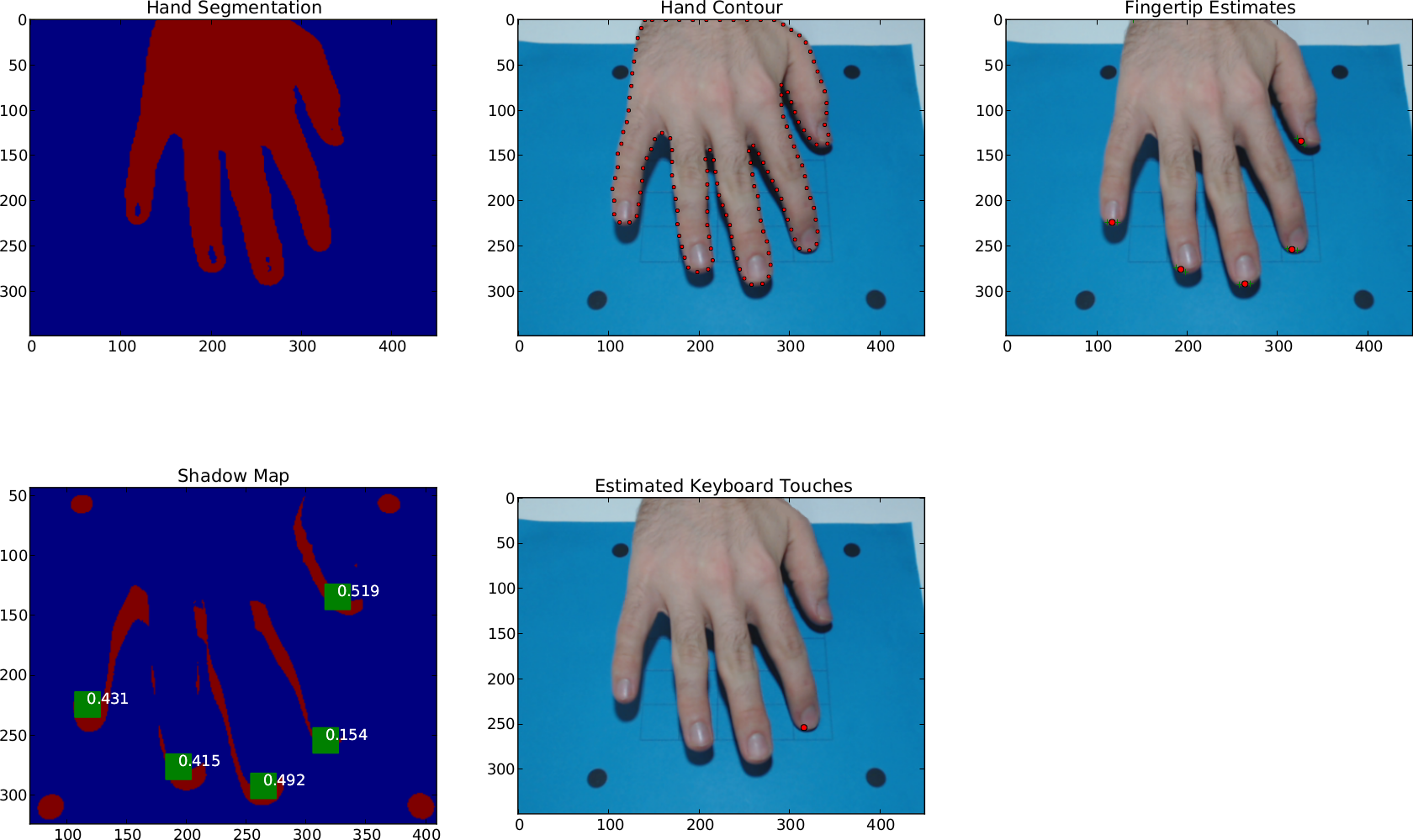A Camera-Based Virtual Keyboard System
In the Fall of 2013, I developed a camera-based keyboard system as my term project for an image analysis course. This page provides a brief summary of my project.
In my system, a webcam looks down on a user's hands, which rest on a paper keyboard template. My program collects images from the webcam to determine when and where the user touches the keyboard template. When the user touches a key, my program produces the corresponding letter as output.
Virtual keyboards are still actively researched in computer science and electrical engineering. The system I implemented uses techniques published in [1]-[3] between 2010 and 2013. Camera-based virtual keyboards require a number of interesting image analysis techniques to implement. They are particularly of interest in mobile applications and in areas where one would like to avoid the cost of a physical keyboard (for example, projects providing computers to people in the developing world).
Processing Steps
The virtual keyboard system I implemented needed to solve three main problems:
-
Detect the locations of the user's fingertips.
-
Detect whether any fingertips are in contact with the tabletop.
-
When a fingertip touches the tabletop, determine which key was pressed on the keyboard.
The first problem can be solved by segmenting an input image \(I\) into two regions: one representing the hands and another representing the background. For each connected component of the hand region, we can extract a contour \(\gamma\) that traverses the boundary counterclockwise. Places where \(\gamma\) has high curvature (the places where \(\gamma\) bends the most sharply) typically correspond to fingertips.

I addressed the second problem using a technique called shadow analysis, which is discussed in [1]. With this technique, we perform another segmentation on \(I\), to locate the regions in the image that represent the shadows of the user's hands. Then, we examine small neighborhoods near the user's fingertips. If the proportion of shadow-pixels in a given neighborhood is above a certain threshold, we infer that the corresponding fingertip is not in contact with the tabletop (because it has a shadow). Otherwise, we declare that fingertip to be touching the keyboard.
The last problem is solved by making some assumptions about the geometry of the keyboard and imaging system. I assumed that the keyboard template displays four easily identifiable control points arranged in a rectangle, and that the front edge of the control rectangle is parallel to the \(x\)-axis of the camera's coordinate system. With these additional assumptions, it isn't too hard to invert the perspective projection and recover the keyboard-space coordinates of each keypress from the image-space coordinates of the fingertips.
Results
After implementing my virtual keyboard system in python, I analyzed its performance under different lighting and usage conditions. My tests suggest that a camera-based user interface that uses shadow analysis will work best under conditions where one has fine control over the lighting conditions and the user does not need to enter very much data at one time. For example, a camera-based user interface would work well in an interactive museum exhibit, but it might not be a very good tool for word processing in a dark coffee shop. Currently, camera-based keyboards cannot provide the speed and accuracy achievable on physical keyboards (but for that matter, neither do touchscreen keyboards).
Downloads
Below are links to the paper and code I wrote for the term project. I used the code within ipython to conduct my experiments, and used the OpenCV project to get data from the camera. OpenCV's support for python is still under development, so if you examine my code you may have to adapt it to work with your particular hardware and copy of OpenCV.
-
Paper: A Camera Based Virtual Keyboard with Touch Detection by Shadow Analysis
-
Project Code: vkeyboard.zip
References
-
Y. Adajania, J. Gosalia, A. Kanade, H. Mehta, and N. Shekokar. Virtual keyboard using shadow analysis. In Emerging Trends in Engineering and Technology (ICETET), 2010 3rd International Conference on, page 163 to 165, 2010.
-
E. Posner, N. Starzicki, and E. Katz. A single camera based floating virtual keyboard with improved touch detection. In Electrical Electronics Engineers in Israel (IEEEI), 2012 IEEE 27th Convention of, page 1 to 5, 2012.
-
M. Hagara and J. Pucik. Fingertip detection for virtual keyboard based on camera. In Radioelektronika (RADIOELEKTRONIKA), 2013 23rd International Conference, page 356 to 360, 2013.